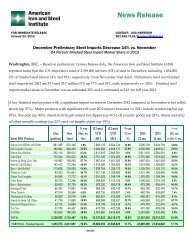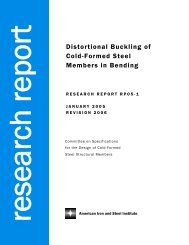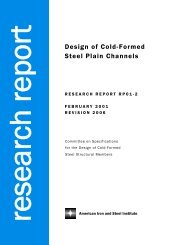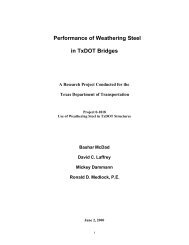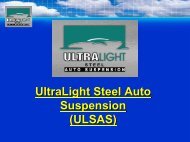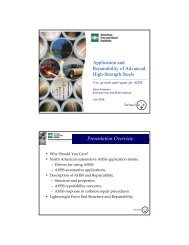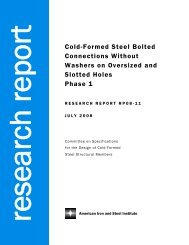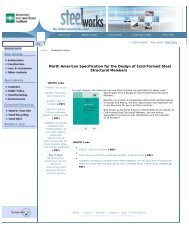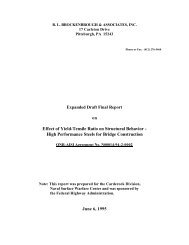Environmental Life Cycle Assessment of Southern Yellow Pine ...
Environmental Life Cycle Assessment of Southern Yellow Pine ...
Environmental Life Cycle Assessment of Southern Yellow Pine ...
Create successful ePaper yourself
Turn your PDF publications into a flip-book with our unique Google optimized e-Paper software.
EXECUTIVE SUMMARY<br />
As well as the direct disturbance to converted wetlands, these activities indirectly affect downstream <br />
receiving water bodies and wetlands. Conversion <strong>of</strong> wetlands to forests leads to significant nutrient <br />
loadings from the decomposition <strong>of</strong> dewatered coastal plains soils, with affected downstream biomes <br />
including rivers, downstream freshwater wetlands, and coastal brackish wetlands. These indirect <br />
effects have resulted in large areas <strong>of</strong> wetlands experiencing partial disturbance throughout the <br />
Southeastern US, as wetlands are converted from one form to another (e.g., from forested <br />
freshwater wetland to emergent wetland). These impacts have resulted in disturbance to the <br />
hydrology <strong>of</strong> affected freshwater and wetland biomes over large areas. 25<br />
While disturbance to wetlands is still ongoing, the majority <strong>of</strong> wetland conversion occurred in the <br />
19 th and early 20 th century. From the 1780’s to the mid-‐1980’s, Alabama lost between 50-‐95% <strong>of</strong> its <br />
wetlands, with Georgia and Florida losing as much as 50%. 26 The conversion to even-‐aged plantation <br />
stands was at its peak in the early 1900s, when ambitious attempts to drain and convert wetlands <br />
were well underway. In the 1930's, the U.S. Government provided essentially free engineering <br />
services to farmers to drain wetlands; in the 1940's, the Government continued to share the cost <strong>of</strong> <br />
drainage projects. This included coordinated efforts to remove surface water from wetlands, <br />
resulting in notable wetland losses between 1900 and 1950 in Alabama, Georgia, and Florida. 27<br />
Even after this era <strong>of</strong> significant wetland conversion, until the mid-‐1990s, the impacts <strong>of</strong> forestry on <br />
wetlands were virtually unregulated. Activities such as earthmoving, planting, seeding, cultivating, <br />
minor drainage, and harvesting, were exempt from regulation under Section 404 <strong>of</strong> the Clean Water <br />
Act. 28 In the 1990s, state and federal government regulatory agencies began to provide guidance to <br />
clarify circumstances where forestry operations required permitting under the Clean Water Act.<br />
Permits were required, however, only in certain forested wetland types. <br />
While large-‐scale conversion rates <strong>of</strong> wetlands to forest management operations have declined in the <br />
region since the first half <strong>of</strong> the 20 th century, the converted and disturbed wetlands are in a <br />
persistently disturbed state; these impacts are still attributed to the wood utility pole system, due to <br />
the historical nature <strong>of</strong> the baseline condition. <br />
Additionally, disturbance is still occurring to wetlands as a result <strong>of</strong> silviculture. Some activities <br />
associated with forest plantations that cause disturbance to freshwater biome and wetlands include: <br />
site preparations and timber stand management practices that alter or eliminate site hydrology; <br />
construction <strong>of</strong> forest roads required to access cut timber sites; installation <strong>of</strong> drainage ditches <br />
through existing wetlands; bedding <strong>of</strong> sites; subsurface drainage; and levee construction, filling, and <br />
channelization (see Table 5). 29<br />
25 Personal correspondence, Steven I. Apfelbaum, Applied Ecological Services, Inc. Dated 3/22/3012, 4:13AM. <br />
26 Dahl, T.E. and G.J. Allord. 1996. History <strong>of</strong> wetlands in the conterminous United States. In. J. D. Fretwell, J.S. Williams, and <br />
P. J. Redman (compilers) National Water Summary on Wetland Resources. U.S. Geological Survey. <br />
27 Ibid. <br />
28 U.S. Fish and Wildlife Service, Fisheries and Habitat Conservation: Status and Trends <strong>of</strong> Wetlands in the Conterminous <br />
United States, 1987-‐1998 (Report to Congress). T.E. Dahl. <br />
29 Ibid. <br />
April 2013 | ©SCS Global Services <br />
ES-‐ 15



